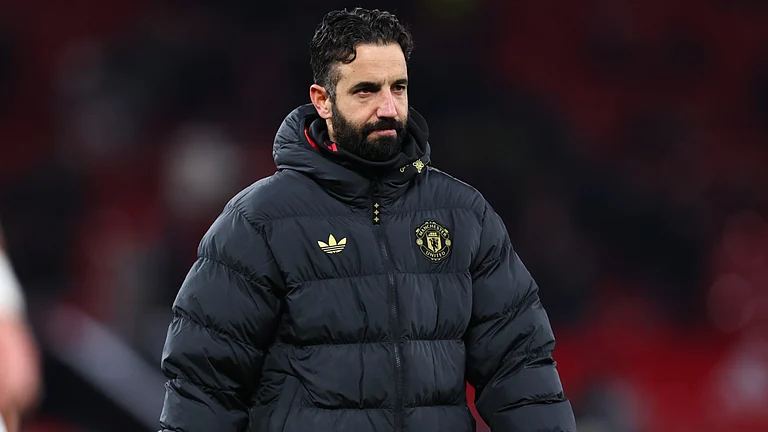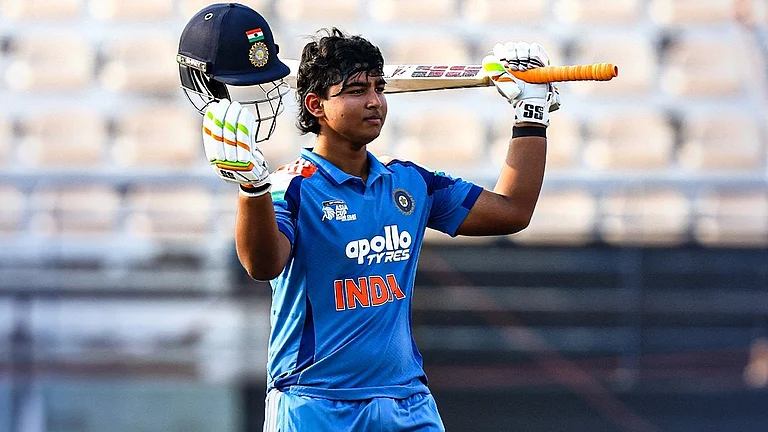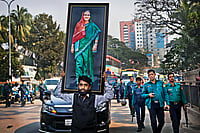Time moves in a straight line according to Western notions. But on the sun-baked edges of the Near East, time can get seriously warped. In Afghanistan, it turned full circle the other day—and so, in a year not untouched by epochal tragedy, we now have one more to contemplate. The Taliban are back. They took Kabul without firing a shot. This stunning collapse was the story in city after provincial Afghan city—minimal fighting, except in Herat and a few other places—as the Taliban spread like a pandemic, its takeover near-total. Their second coming imparts a tectonic shock to a whole trans-Asian region— those affected by this born-again Kalashnikov caliphate include India, China, Pakistan, Russia, Iran and the Central Asian republics. The old theatre of the Great Game, to be precise, with a new 21st century edition promised now—complete with untold humanitarian tragedies as footnotes.
What brought this about? The spectre of American military imperialism in one more historical retreat. Twenty years after invading Afghanistan with a posse of global policemen—out hunting Osama bin Laden after 9/11—the Americans have literally handed the country back to their enemy on a platter. The Afghan National Defence and Security Force (ANDSF) collapsed like a house of cards. The army just put down their weapons and switched loyalties, in the age-old fashion of Afghan warlords who sense defeat. In the words of Kabul-based journalist Asad Kosha, “Afghan history has long been witness to this. It has happened time and again.” The Ides of August, 2021, was in many ways a tragedy foretold.
A transitional government is in the works now; negotiations were on even late Wednesday night to give it shape—leading up to a meeting between former president Hamid Karzai, who has magically reappeared to oversee the transition, and Mullah Abdul Ghani Baradar, the man tipped to be president. Baradar, who has spent 20 years outside Afghanistan, returned on Tuesday prior to an imminent coronation—perhaps with Taliban top man Hibatullah Akhundzada as an ayatollah-style supreme leader. The international community, though its ability to control the script is vastly reduced now, insists the regime should have representation from all groups, including ethnic minorities. In recent times, Karzai, once an object of hate for the Taliban, has mended fences with the group—attending several intra-Afghan discussions. Some reports recall his old association with the Taliban, dating back to 1994, when also he was reported to have had a mediating role. Anyway, the Taliban hold all the aces, they will call the shots. The one difference from their last outing visible straight off is a kind of more tactical diplomatic language—as a Tuesday press conference showed. Some conciliatory words—especially on women’s rights (“within the framework of Islamic law”), media freedom and a general amnesty—showed that they crave international recognition this time. With that end in mind, they may even bring an inclusive interim arrangement. But actual power, of course, will rest with the Taliban. And all bets are off on whether those words will be kept, in the cities that have lived a more liberal life for two decades now, or out in the provinces.

Afghans displaced from their homes
All remnants of the former administration have disappeared. President Ashraf Ghani fled the country on Sunday, August 15. On Monday morning, heavily armed Taliban fighters were all over the presidential palace, stretching out and making themselves comfortable in its luxurious settings. As the Taliban flag was unfurled above, they declared the end of the war and the establishment of the Islamic Emirates of Afghanistan, to be ruled by Sharia laws. The country is back to where it was before 2001, when US and NATO forces invaded Afghanistan and threw out the Taliban. There has been a dramatic change overnight. Burqas and chadors are back: shops selling these are doing roaring business. Billboards featuring women are being washed clean. Men are going back to the traditional shalwar kurtas. America, in its hurry to get out of a never-ending war, has wound the clock backwards.
Ordinary Americans have supported both the Trump and Biden administration’s decision to bring the troops home from a foreign war that was going nowhere. But the way it was done brought to mind the fall of Saigon and America’s haphazard withdrawal on April 30, 1975. As Saigon fell to Communist forces, the Americans and South Vietnamese supporters had to scramble on to helicopters from the embassy compound and board a carrier waiting at sea. The iconic images of those times were of South Vietnamese collaborators scrambling to get on to the US navy choppers. The American accommodated as many as they could, but in the end were overwhelmed by the numbers and had to push as many away. The Vietnam War was till then the longest and most unpopular war in American history.

People gather at Kabul airport
US officials are vehemently denying any comparison to Vietnam; secretary of state Antony Blinken laboured the point in media interviews: “This is manifestly not Saigon.” And yet, the eerily similar scenes at Kabul airport have now become a dark visual fable playing all over the internet. From Sunday itself, when it became clear that Taliban fighters had reached the capital, cars were heading to the airport in a desperate attempt to catch the last flight out. On Monday, embassy personnel were ferried out from their walled-off compounds to the airport. Some 6,000 American troops were sent in to help the evacuation and yet chaos reigned. Everyone saw those heart-rending images: Afghans running alongside an aircraft revving up for departure, trying to cling on to anything projecting out from the fuselage. Five Afghans died in the melee. A video caught a man falling off mid-air; the world recalled, with a shudder, the famous Falling Man of 9/11. History was being writ in some black poetic rhythm.
The manner of America’s exit—both the unplanned, poorly organised evacuation and the larger withdrawal—reflects poorly on the Biden administration. What surprised people most was the US intelligence report that had claimed the Taliban takeover would take six months. How could they get it so wrong? Did they have no humint on the ground even after 20 long years? More embarrassing parallels: after the fall of Saigon, the North Vietnamese Colonel Bui Tin, talking to South Vietnamese troops who fought on the side of the US, reassured them: “You have nothing to fear; between the Vietnamese, there are no victors and no vanquished. Only the Americans have been defeated.” Compare to Zabihullah Mujahid’s words at the press conference about there being “no internal enemies”.
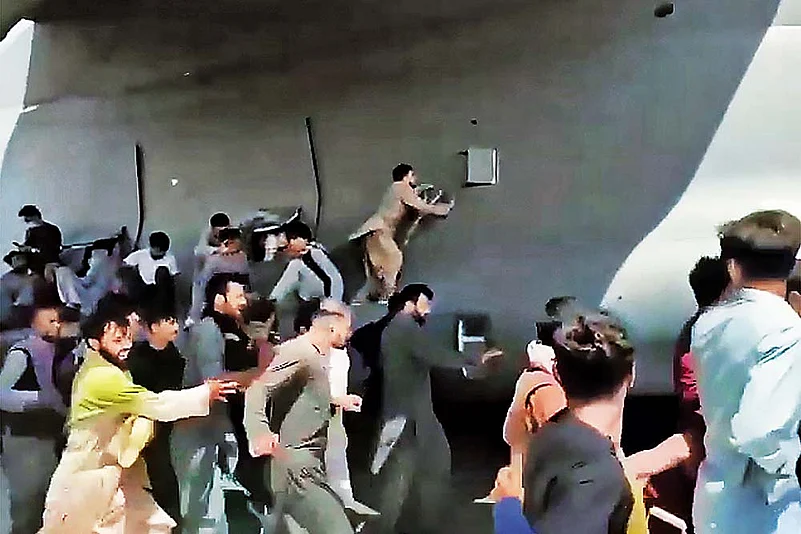
People try to board a USAF plane revving up for takeoff, five were killed
Will the Taliban really be as generous in victory? They have talked of a general amnesty and asked government officials to return to work. How long will this last? So far, those in the Afghan National Army who have surrendered have been spared, except in a few places where they were shot dead. Will this extend to the larger population? Those who worked for the government or with American NGOs, companies and contractors? That willy-nilly leads to the other question on everyone’s mind: have the Taliban changed in the last 20 years?

In one respect, yes. One section, the one that spent its years in exile in Doha, has learnt the ropes of diplomacy. So far they have been making the right noises about the rights of women and girls’ education within Sharia laws—that is a given. What does that mean for public flogging and stoning of women accused of infidelity, or for young girls being picked up and forced to marry? No clear answers yet. Reports from the ground in Herat talk of women students from the university being asked to go home. From Ghazi comes news of a child being tortured, simply because its uncle was a policeman. Some 28 civilians were killed in Ghazni for being anti-Taliban. Ahmad Qais Munhazim, living abroad, appealed on Twitter: “Taliban has threatened my sister, a lawmaker in Kabul…. Please connect me with anyone you know is doing the evacuations to any country.”
Perhaps those old scenes of public executions in football stadiums, the hallmark of its previous rule, may not be exactly replayed. The world itself has changed—the density of connections is different, and with mobile clips that mean nothing can be concealed for long, the Taliban realise the world is watching. All that splendid isolation of Mullah Omar’s time is truly a thing of the past. But what turn will things take after the Taliban settle down with someone like Mullah Baradar on the throne? Afghans living in cities believe it is back to the old days, with a new veneer; that with most Taliban fighters coming from a rural religious background, not much can change.

“The situation is precarious because nobody really knows how the Taliban will be in 2021. Pakistan has been telling the world that it is Taliban 2.0, but there is little to support such a claim,” says Rakesh Sood, a former ambassador to Afghanistan. The international community is warning the Taliban not to go back to the old days. “An Afghanistan that does not respect the rights of its people, an Afghanistan that commits atrocities against its own people, would become a pariah state,” Blinken had said during a visit to India last month. But since nobody can quite read the Taliban’s mind, the potential effect on Afghan society remains as much in the grey as the spinoffs on geopolitics. In Sood’s words, “An unstable Afghanistan or one fully under Taliban control creates instability in the region and increases Pakistan’s influence for the foreseeable future.”
China-Russia-Pakistan: There is much talk of this new ‘axis’, especially if you also throw in Iran—prima facie, a rather unstable axis. China has declared it is ready to deepen “friendly and cooperative” relations with Afghanistan—Pakistan has helped develop this new engagement. With Chinese foreign minister Wang Yi meeting Baradar in Tianjin in July, Beijing appears to have got reassuring signals. But there is caution, and also abundant need for it. Wang Yi stressed that the East Turkestan Islamic Movement (ETIM) poses a threat to China’s national security and combating the terror group is a common responsibility of all nations.
What is binding them all together is the sense of common enemies—and economics. The Taliban is looking to China for funds and buying into the idea of extending the Belt and Road Initiative and the China-Pakistan-Economic Corridor to Afghanistan, which would help it build connectivity to the larger Central Asian Republics. Russia is playing its cards right too with the Taliban, with its ambassador in Kabul being among the first foreign diplomats to meet the Taliban since the takeover. For Pakistan, the Taliban victory has been a windfall. Having Kabul nudge closer to Islamabad—rather, Rawalpindi—is what the ISI and the Pakistan military had aimed for since the ’90s. Prime Minister Imran Khan has praised the Taliban for breaking the “shackles of slavery”. That it is a leader of a faction bred by Pakistan, Anas Haqqani of the Haqqani network, who is presently leading the talks with Karzai—setting the stage for eventual talks with Baradar—is hardly without significance. That India’s footprint in Afghanistan is drastically reduced is a simultaneous cause for joy in these circles.
India’s Security Concern: A major worry for India is the prospect of Afghanistan gradually returning to being a terror hub. Several Islamic terror groups are in the country and have close links with the Taliban—Al Qaeda, ETIM, Tehreek-e-Taliban (TTP), Islamic Movement of Uzbekistan, the Lashkar-e-Toiba (LeT). The Haqqani network, an organic part of the Taliban, is known to be a “lynchpin of the ISI” and was formally listed as a terror organisation by the US in 2012. Afghan and American intelligence have held Sirajuddin Haqqani, deputy leader of the Taliban, responsible for the Indian embassy bombing in July 2008. Afghanistan’s permanent envoy to the UN, ambassador Ghulam M. Isaczai, warned that 10,000 foreign fighters representing 20 groups were fighting alongside the Taliban. The LeT is one of them. Foreign fighters have been seen in their ranks even in their latest blitz across the Afghan map. It does not take long for the line to extend from here all the way to Kashmir and beyond: the fear is that an Afghanistan consolidated behind a hard Islamic Taliban gives Rawalpindi a new strategic depth in the old game of using terror as statecraft. “This is one of the things to watch. Prima facie, given the Taliban’s dependence and ties with Pakistan, New Delhi has to be careful. Taliban assurances cannot be taken at face value. Again we have to see what they do, not what they say to gain legitimacy. India should proceed with eyes wide open,” says ambassador Gautam Mukhopadhaya, another former envoy to Afghanistan.
Ajai Sahni, an expert on counter-terrorism and executive director for the Institute of Conflict Management and South Asia Terrorism portal, says no one at this stage can make predictions. “But the Taliban, at this stage, will not be too eager to attract negative international attention. It is well known that the Taliban have not delinked with Al Qaeda or the ETIM. They will be discreet for now. In the long term, I don’t know how this will pan out, whether they will be ready to openly help terror groups. We have to watch till the situation stabilises in Afghanistan. It is early days yet.” He feels that if India plays its cards right, it won’t face too much of a problem; the Taliban, Sahni believes, is not strictly speaking anti-Indian. They are concerned primarily about Afghanistan, and unlike groups like Al Qaeda, are not into spreading the jehadi doctrine across the world. However, Sahni adds, the way they forced American and NATO forces into a historic retreat is being viewed as a ‘victory for Islam’ by many hard Islamist groups. “Jehadi groups scattered across the globe will take inspiration from the Taliban fight against the US. It could give a new lease of enthusiasm to many fundamentalist extremist outfits.”
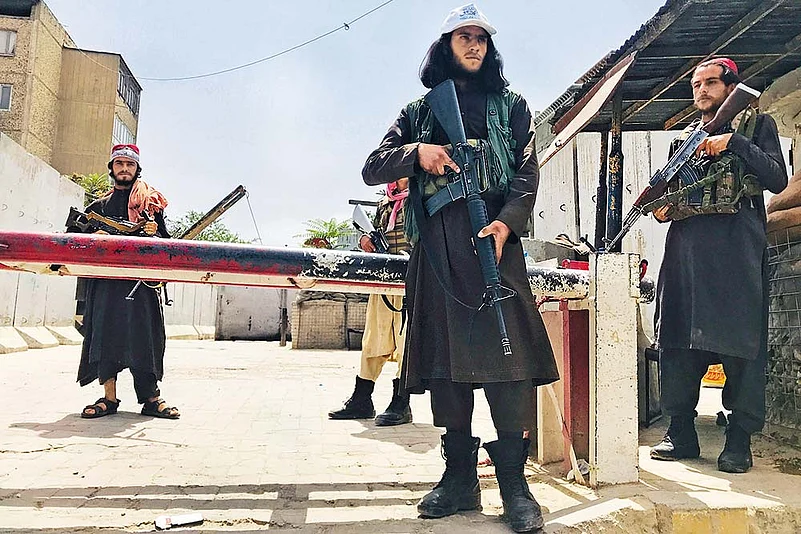
Taliban fighters stand guard at a checkpoint near the US embassy that was earlier manned by American soldiers
India and the Taliban: Like the rest of the international community, India had been parroting the “Afghan-led, Afghan-owned, Afghan-controlled” mantra—a euphemism for the US-propped regime. All that is history now. So how does India tackle a Taliban government in Kabul? There has been much criticism of the Modi government’s policy on Afghanistan. Critics are unhappy that India’s $3 billion investments in Afghanistan will now go waste. Others who have an exaggerated view of India’s power in the region are unhappy at New Delhi’s reduced role now. To be sure, at the last moment, India did reach out to the Taliban and hold meetings in Doha, but many former diplomats endorse the tack till now adopted by New Delhi. “India was absolutely right in dealing with the elected government in Kabul. We always respect the people’s verdict. It is in line with our belief in democracy and women’s rights, there was no other way,” says P.S. Raghavan, chairman of the National Security Advisory Board (NSAB). He believes India should wait and watch before recognising the Taliban government in Kabul. To critics who wanted India to rush out and court the Taliban earlier, Raghavan advises strategic patience.
Once the dust settles in Afghanistan, development will certainly take centrestage again. That is when India should make its move. India’s development projects in Afghanistan have won hearts and minds because many of these small schemes have touched the lives of ordinary Afghans. India can then assess what can and should be done, says Raghavan. Afghanistan’s tragedy is that nearly all regional and foreign players have their own agenda and want to use it for furthering their interests. “The future of Afghanistan is in the hands of too many players more interested in their strategic interests rather than the welfare of the people of Afghanistan,” says Raghavan. That unfortunately has been the history of Afghanistan down the ages.
Mukhopadhaya agrees with the NSAB chief that India was right in not talking to the Taliban earlier. He assumes whatever limited interaction it had was likely over security issues relating to Indians working in Afghanistan. “Early engagement would have legitimised the Taliban without getting us anything in return. Now that they have taken power through the gun, it is to be seen how inclusive they will be and how they conduct themselves. We should wait and see how things evolve, bearing in mind Afghan sentiments, before deciding our course of action.” Whether India should bend with the times, that is.
***
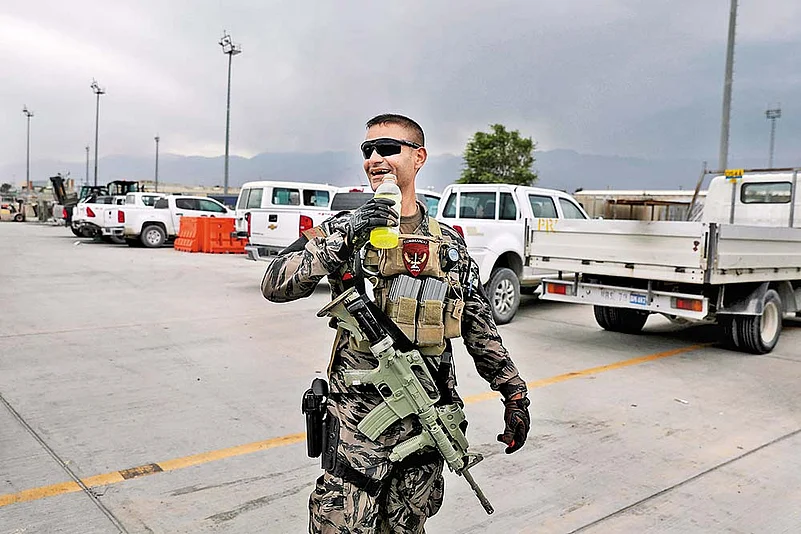
Why Did The Afghan Security Forces Collapse?
The short answer: Corruption. The US and its Nato allies spent billions of dollars over two decades to train and equip Afghan security forces. But the Western-backed government was rife with corruption. Commanders exaggerated the number of soldiers to siphon off resources, and troops in the field often lacked ammunition, supplies or even food. Their morale further eroded when it became clear the US was on its way out. As the Taliban rapidly advanced in recent days, entire units surrendered after brief battles, and Kabul and some nearby provinces fell without a fight.
Source: AP
***
What Does The Taliban Takeover Mean For Women?
Many fear it could mean a severe rollback of rights. Afghan women have made major gains in the 20 years since the overthrow of the Taliban. Many are worried they will once again be confined to their homes and their every move will be restricted, even the simplest things such as getting groceries in the absence of a male escort. Many fear the Taliban will reimpose the harsh interpretation of Islamic law that they relied on when they ran Afghanistan from 1996 to 2001. Back then, women were barred from attending school or working outside the home. The Taliban have sought to present themselves as a more moderate force in recent years and say they won’t exact revenge, but many Afghans are sceptical of those promises. The Taliban have said they are no longer opposed to women attending school, and have vowed to honour women’s rights “according to Islamic law”. Enamullah Samangani, a member of the Taliban’s cultural commission, said the group was ready to “provide women with an environment to work and study, and the presence of women in different (government) structures”. So far there were no signs the group was forcing women to wear a burqa, the all-encompassing blue robe women were forced to wear under Taliban rule. But these are early days. Older generations remember the Taliban’s ultraconservative Islamic views, which included severe restrictions on women as well as stoning, amputation and public execution.
Source: AP
***

Pragmatic Mullah Is The Man To Watch
The Taliban’s top political leader, Mullah Abdul Ghani Baradar, is expected to play a key role in the Taliban government. Seen in his signature black turban and vest over a white robe, the bespectacled Baradar is far more visible than the Taliban’s current supreme leader, Maulawi Hibatullah Akhunzada. Baradar’s biography charts the arc of the Taliban’s journey. Baradar, who is in his early 50s, was born in the southern Uruzgan province. Like others who would eventually become Taliban leaders, he joined the ranks of the CIA- and Pakistan-backed mujahideen to fight against the Soviet Union during its decade-long occupation of the country that ended in 1989. Baradar is the only surviving Taliban leader to have been personally appointed deputy by the late Taliban commander Mullah Mohammed Omar, giving Baradar near-legendary status. In 1994, Mullah Omar, Baradar and others founded the Taliban in Kandahar. During the group’s 1996-2001 rule, Baradar spent most of his time in Kandahar and did not have an official government role. After the US invaded Afghanistan following the 9/11 attacks, Baradar and Omar fled into Pakistan. Baradar was arrested in Karachi in 2010. By 2018, the Taliban had seized effective control over much of Afghanistan. The Trump administration, looking for a way out of Afghanistan, persuaded Pakistan to release Baradar that year and began pursuing peace talks with the Taliban. Baradar led the Taliban’s team in Qatar through several rounds of talks, culminating in a 2020 peace agreement. He has said little about how the group will govern, but has proven pragmatic in the past.
(This appeared in the print edition as "Return of the Taliban")
Source: AP










